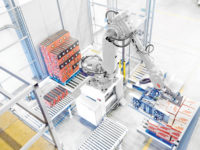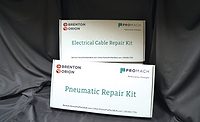Improving Flexibility
By JOANNA COSGROVE
Beverage manufacturers are in search of labeling
equipment that is fast and versatile
Container graphics are one
of the most important beverage image-definers on the shelf, but labeling a
beverage container can be a tricky proposition. Container shapes can be
unwieldy, requiring monkey-wrenched placement accuracies, and wet and/or
hot processing environments can make a lasting label application difficult,
at best.
“Various container shapes, stability and sizes
require a unique movement throughout the labeler to ensure proper
dressing,” says Mike Scheitinger, product manager of the labeler
division at KHS USA Inc., Waukesha, Wis. “Each product labeled can
have its own specific settings.”
Scheitinger says recent equipment advancements like
the VarioDrive allow KHS to meet and prepare labeling equipment for future
products. The VarioDrive is part of KHS’s Innoket SE line of labeling
machines. With labeling capacities of 75,000 bottles per hour, the Innoket
SE features a simple central labeling carousel design, and each labeling
station is equipped with a servo drive.
During the course of production, when labeling
stations are changed, the unit’s computer software automatically
synchronizes the stations. Mounting and removing stations is achieved via
coupling and decoupling at one of the station locations provided on the
labeling carousel. The Innoket SE concept orients each labeling station so
it can be positioned flush with the top of the processing table. An
adjustable foot, which can be positioned automatically or manually,
compensates for unevenness in the floor, guaranteeing accurate alignment of
the station with the machine.
Whether mechanically controlled cam rotation or
VarioDrive, both types are possible with the Innoket SE. Electronic
VarioDrive bottle plate control provides maximum flexibility. In this case,
plate, motor and electronic equipment form a single
“plug-and-label” unit and communicate directly with one
another. Each individually required container rotation can be geared
exactly to the container format and style of dressing.
An additional advantage of VarioDrive is the length of
the label to be applied is not limited by the machine pitch. Label lengths
can extend beyond the machine spacing by programming further rotation for
the particular style of container. Cut-and-stack or roll-fed wraparound
labeling is also possible.
In conjunction with a camera-based alignment system,
VarioDrive achieves precise container alignment together with maximum
labeling quality. With the Innoket SE, this also can be added in the form
of a module to solve even demanding labeling tasks, such as the accurate
application of a label in a special embossed area of the container, or the
accurate placement of a clear label with a no-label look outside the glass
seam.
Krones Inc., Franklin, Wis., also has addressed
flexibility with its Modul System, which is designed with modular,
interchangeable labeling stations. Utilizing a plug-and-label principle,
the Modul labeler combines multiple labeling techniques, such as cold-glue,
pressure-sensitive, hot-melt roll-fed and hot-melt pre-cut wraparound
labels, all on a single machine base, making it an ideal system for
facilities that label multiple lines, or for contract packagers because a
variety of labels can be run simultaneously or exchanged easily. The Modul
features a compact, ergonomically friendly bottling table, reducing both
setup and handling parts changeover time, resulting in lower service and
maintenance costs. Also, the bottle table and the labeling stations each
have their own drives, which allows for further flexibility.
Shrink-labeling
If it weren’t difficult enough to accurately
apply a label to a rounded beverage can or bottle, newer, non-traditional
beverage container shapes are posing unique challenges for manufacturers of
labeling equipment, especially when it comes to shrink-labeling.
“With more and more beverage companies getting into shrink-labeling,
the shrink-label no longer stands out as much as it did in the past when it
was on the shelf next to a paper labeled container,” comments Gary
Tantimonico, vice president, PDC International Corp., Norwalk, Conn.
“Companies now are designing odd-shaped containers that can be
difficult to apply a label, and even more difficult to shrink
it.”
In addition to the increased shrinksleeve labeling of
odd-shaped containers, Tantamonico says beverage manufacturers want faster,
more accurate outputs in processing environments that are oftentimes less
than ideal.
“Beverage manufacturers are looking to run very
high speeds, and at times, sleeve containers that are wet when they come to
the labeler because of their internal processes,” he says.
“Sleeving a wet container can cause the sleeve to hang up and not
position itself all the way down. We work through these applications by
adding accessory options to our machine to assist in positioning the
sleeve.”
The Marathon U series of roll-fed labelers from
B&H Labeling Systems, Ceres, Calif., features a 180-degree U-shaped
conveyor and a servo-driven infeed feedscrew, which helps to maximize
container stability and production speeds while offering processors another
line configuration option with right side infeed and right side discharge.
The line’s Marathon XLU, the fastest labeler in
the B&H family, handles containers from 8 ounces to 3 liters at speeds
as fast as 700 containers per minute. Marathon labelers employ an
all-electric drive train, called Smartdrive. With five independent
servomotors and digital, multi-axis timing control, the Marathon U Series
labelers eliminate complex mechanical linkages such as gears, belts and
chains. Compared to complex rotary labelers often used to achieve high line
speeds, Marathon simplifies operations, maintenance and changeovers using
fewer moving parts and digital automation, improving reliability and
uptime.
With its U-shaped conveyor, the Marathon U Series
increases the dwell time of product in the starwheel, providing greater
container stability. B&H guarantees labeling defect rates of less than
0.05 percent with all Marathon roll-fed labelers.
Marathon also boasts changeover times of less than 15
minutes from one full production speed to the next, thanks to
container-specific “recipe downloads” that enable automatic
machine setting adjustments. Lightweight, color-coded RCO (Rapid
Changeover) change parts further ease changeover.
Built on a modular platform, B&H can configure
each Marathon to offer tailored capabilities to meet the specific needs of
each packager. The U Series labelers can be equipped with an optional
handle orientation feature that applies labels to containers in relation to
the container handle in precisely the same position every time, improving
package uniformity.

